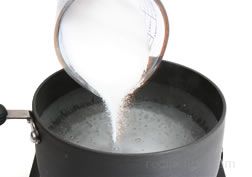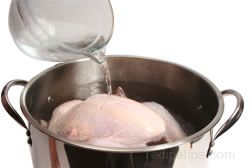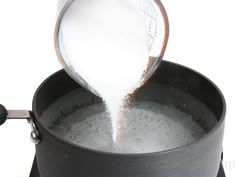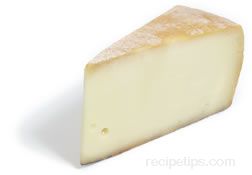Foods such as chicken, pork, turkey, fish, and shrimp, which are considered lean meats, are good foods to brine. However, before brining it is always wise to check to see if the food has been "pre-basted" with a marinade or brined seasoning flavored with a brining spice. As an example turkey, pork or beef processed by major manufacturers and food processors, is often pre-basted with a flavor enhancer or moisturizing agent that may affect the value of brining again. Brining a pre-basted meat often results in overly soggy meat, since too much moisture could be added by brining.
To make one gallon of brine for smaller to medium-sized food items, use:
This portion can be increased or decreased depending on the size of the item being brined. As an example, if a whole fresh turkey (12 to 14 pounds) is being brined, use 2 gallons of water, with 1 cup of salt and 1 cup of sugar.
To prepare the brine, mix the salt and sugar with half of the water required in a large non-reactive pan or stockpot if large poultry is being brined. A non-reactive material is required so the salt does not affect the finish. Place the pan/stockpot on high heat and allow the mixture to dissolve into the water by stirring periodically. After the solution is completely dissolved, turn off the heat and remove the pan so it can cool. When the solution is cool, add the remaining quart of cold water for medium to small items or the remaining one gallon if brining a large turkey. Using a large pan, a stockpot, or a brining bag, submerge the food completely in the water and place the brine container holding the food in the lower section of the refrigerator for 6 to 8 hours if small in size or 12 to 24 hours if larger. It is wise to occassionally turn the food being brined to make sure all parts of the meat are brined. If using a brining bag, remove all the air in the bag and seal it tightly to make sure it will not leak. Although a bag made for brining is heavy duty and is typically secure, it is always a good idea to consider placing the bag filled with solution into a deep pan, bowl or the refrigerator vegetable crisper in case the bag should leak. Discard the bag after the meat has been brined.
When brining, keep the food at a temperature of 39º F or less so bacteria is not allowed to grow. An alternative to adding salt to the water is to rub a salt or a salt and seasoned mixture over the entire piece of food being brined. Then place it in the water, allowing the salt to desolve as it brines. After brining is finished, wash the excess solution off the surface of the food, discard the used brine (never reuse) and begin cooking.













